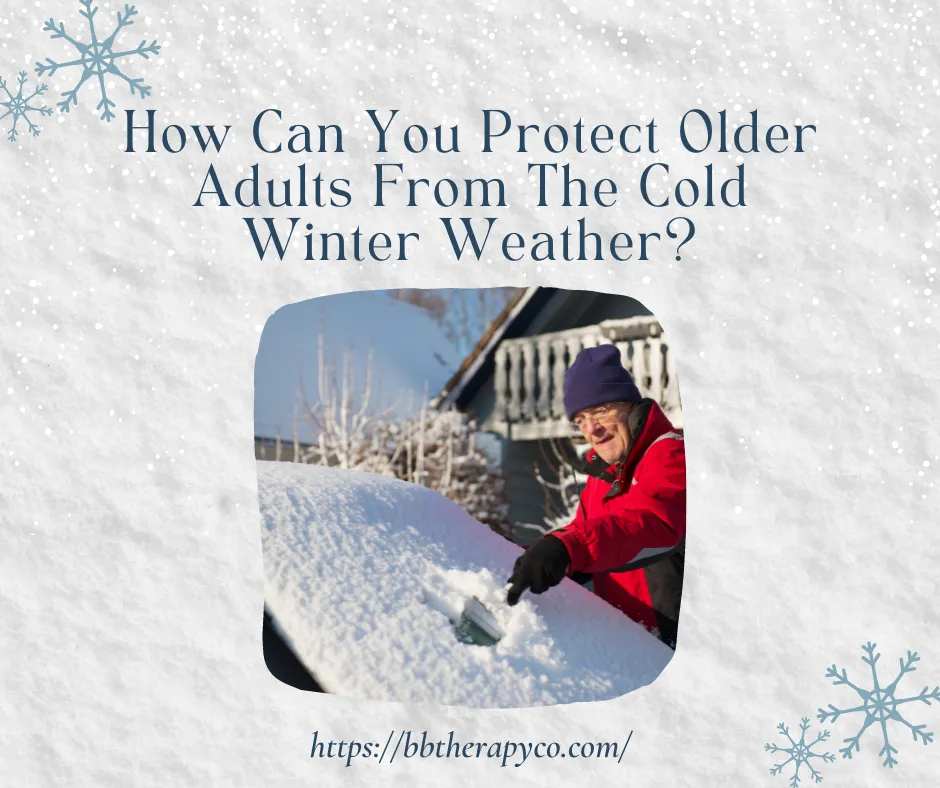BlueBird Blogs and Articles
Welcome to the blog for BlueBird Therapy and Wellness, your local occupational therapy business in Denver, CO. We're passionate about helping people of all abilities achieve their goals and live their best lives.

How Can You Protect Older Adults From The Cold Winter Weather?
How to protect older adults from the cold winter weather?
The winter season brings different challenges, including icy conditions, dangerously cold temperatures, and piles and piles of snow here in Colorado. It can be difficult trying to stay safe in the winter months, especially for older adults. With winter being upon us, how can we protect older adults from the cold winter months? Let’s look at some different safety concerns during the winter season, and identify how we can protect older adults with from these issues.
Hypothermia: Older adults tend to have a slower metabolism, which in turn decreases their ability to produce body heat. Also, as we age, it becomes more difficult to identify when we are getting cold. Here are some tips to help prevent hypothermia:
Always wear hats, gloves, boots, pants, warm jackets, and a scarf when you are outside.
If you have to go outside when the temperature drops, limit your time outside. Only stay outside for short amounts of time.
Wear two to three layers of clothing that is loose.
Keep dry. If your clothes do get wet, change them immediately.
When indoors, keep the temperature between 68 - 70 degrees.
Don’t stay stationary for long periods of time. Get up and move around!
If you or your loved ones is showing signs of hypothermia (weakness, trouble walking, shivering, confused, tired, pale or ashy skin, slowed breathing) go to the emergency room right away.
Frostbite: Frostbite is an extreme cold that will go all the way down to your bone. This can affect your nose, ears, chin, cheeks, fingers, and toes. Older adults with decreased circulation are more susceptible to frostbite. To decrease the potential of frostbite, cover up all body parts when going outside, dress in warm clothing that is loose, limit time outdoors, if your skin turns red or dark and starts to hurt, go inside right away, and wear hats, mittens, and socks. When the temperature is below 0 degrees, frostbite can occur in as little as 30 minutes outside.
Shoveling: When you are shoveling, it causes your heart to work harder, which in turn can put strain on your heart. Also, the heavy lifting can be a safety concern to an older adult with osteoporosis. Consult with your health care provider prior to shoveling your driveway or sidewalk.
If you are in need of assistance with snow shoveling, A little Help has volunteers around Denver that will come to your house and help with shoveling, if you sign up on their website: https://alittlehelp.org/
Falls: With winter comes ice and snow. With ice and snow comes fall hazards! How can you prevent falls during the winter?
Wear boots that have non-skid soles.
When walking outside in the winter, look for sidewalks that appear dry.
If you use a cane or walker, be sure that the tips on the end are not worn down. That way, they are able to grip better.
Take wide and short steps.
Keep your hands out of your pockets.
Utilize railing, when available, to provide additional support.
Driving Accidents: Just like falls, driving also has the hazards of ice and snow. Here are some tips to increase an older adult's safety when driving in the winter.
Slow down when roads are covered in snow and ice.
Take a cellphone with you.
Keep basic emergency supplies in your car; first aid kit, windshield scraper, shovel, water, dried fruit/nuts, and a bag of sand or cat litter.
Check weather reports prior to leaving the house. If it looks like bad weather is coming or the conditions aren’t good, save your outing for another time.
Check your car's shield wipers, antifreeze, and tires before winter hits. That way, your car will be in good condition before the season changes.
Carbon Monoxide Poisoning: Furnaces that are gas powered and a variety of heating sources, make carbon monoxide poisoning common in the winter time. What are signs of carbon monoxide poisoning? Confusion, dizziness, headaches, and nausea. What can you do to prevent carbon monoxide poisoning? Have a professional inspector look at your chimney, HVAC, and water heater. Turn the car’s engine off as soon as you pull into the garage. Also, have CO detectors installed in your home.
When the winter days get unbearably cold and conditions aren’t as safe for older adults to go outside, you want the ability to continue their normal routine, while avoiding the harsh conditions. That is where Home Therapy Solutions comes in! With Home Therapy Solutions, we provide Occupational and Physical Therapy services in your home. You, or your loved one, does not need to put themselves in harsh conditions to get to an appointment. Also, we will provide tools, tips, and resources for how to modify your home environment, and routine, to increase you, or your loved ones safety during the harsh winter months. Call us today to see what we can do for you! 218-230-2171
Resources used:
https://www.hchcares.org/wp-content/uploads/2016/09/wintersafety_tips.pdf
https://www.whereyoulivematters.org/cold-weather-safety-for-older-adults/

